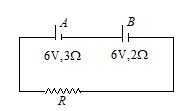Objective Assignment
BOARD LEVEL QUESTIONS ON CONCEPT OF DRIFT VELOCITY, OHM’S LAW
Q.1
A steady current flows in a metallic conductor of non—uniform cross section. The quantity/quantities constant along the length of the conductor is/are
(a) current, electric field and drift speed
(b) drift speed only
(c) current and drift speed
(d) current only
Ans. (d)
Q.2
Electrons in a conductor have no motion in the absence of a potential difference across it.
(a) Always True
(b) always false
(c) may be true
(d) none
Ans. (b)
Q.3
Which of the following statement is correct?
(a) Electrons drifting in a conductor under the influence of an electric field are accelerated by the field.
(b) The drift speed of the electrons in a conductor is of the order of a few mms–1.
(c) All free electrons in a metal drift from a lower to a higher potential.
(d) Since the drift speed of electrons in metal is very small and the charge on an electron is extremely small, only a small amount of current can flow in metals.
Ans. (b)
Q.4
A uniform copper wire of length 1m and cross sectional area 5 × 10–7 m2 carries a current of 1A. Assuming that there are 8 × 1028 free electrons per m3 in copper, how long will an electron take to drift from one end of the wire to the other?
(a) 0.8 × 103 s
(b) 1.6 × 103 s
(c) 3.2 × 103 s
(d) 6.4 × 103 s
Ans. (d)
Q.5
In a discharge tube, the number of protons drifting across any cross-section is 1.0 × 1018 per second while the number of electrons drifting in the opposite direction across another cross-section is 2.0 × 1018 per second. If the voltage across the tube is 240V, what is the effective resistance of the tube?
(a) 300 W
(b) 400 W
(c) 500 W
(d) 600 W
Ans. (c)
Q.6
If no potential difference is maintained between the ends of a conductor
(a) the free electrons move randomly in all directions
(b) the rate at which electrons pass through a certain cross-section from right to left is equal to the rate at which electrons pass through it from left to right
(c) no current flows through the conductor
(d) All of the above
Ans. (d)
Q.7
Choose the wrong statements from the following.
(a) In copper the number of free electrons is of the order of 1029 electrons per cubic meter
(b) At room temperature, the free electrons move with very small velocities in the absence of an electric field.
(c) In metals, the drift speed is of the order of a few mms–1
(d) In insulators, the number of free electrons is negligibly small.
Ans. (b)
Q.8
The drift speed of the free electrons in a conductor depends upon
(a) the material of the conductor
(b) the temperature of the conductor
(c) the potential difference applied across the ends of the conductor
(d) the area of cross-section of the conductor.
Ans. (b)
Q.9
A constant potential difference is maintained between the ends of a conductor having non-uniform cross-section. which of the following quantities will not change along the length of the conductor?
(a) drift speed
(b) electric field
(c) resistance
(d) current
Ans. (d)
Q.10
A current of 1A flows through a copper wire. The number of electrons passing through any cross-section of the wire in 1.6s is (charge of a electron = 1.6 × 10–19C)
(a) 1019
(b) 1022
(c) 1025
(d) 1028
Ans. (a)
Q.11
A uniform wire of length 2.0 m and cross-sectional area 10–7m2 carries a current of 1.6A. If there are 1028 free electrons per m3 in copper, the drift speed of electrons in copper is
(a) 2 mms—1
(b) 5 mms–1
(c) 10 mms–1
(d) 1 ms–1
Ans. (c)
Q.12
A uniform wire of length 2.0 m and cross-sectional area 10–7m2 carries a current of 1.6A. If there are 1028 free electrons per m3 in copper, the time taken by the electrons to drift from one end of the wire to the other is
(a) 200 s
(b) 100 s
(c) 20 s
(d) 2 s
Ans. (a)
Q.13
A current I is passing through a wire having two sections P and Q of uniform diameters d and d/2 respectively. If the mean drift velocity of electrons in section P and Q is denoted by vP and vQ respectively, then
(a) {{v}_{P}}={{v}_{Q}}
(b) {{v}_{P}}=\frac{1}{2}{{v}_{Q}}
(c) {{v}_{P}}=\frac{1}{4}{{v}_{Q}}
(d) {{v}_{P}}=2{{v}_{Q}}
Ans : (c)
Q.14
The current–voltage (I–V) graphs for a given metallic wire at two different temperatures T1 and T2 are shown in the figure. It follows from the graphs that

(a) T1 > T2
(b) T1 < T2
(c) T1 = T2
(d) T1 is greater or less than T2 depending on whether the resistance R of the wire is greater or less than the ratio V/I.
Ans . (a)
Q.15
Two sources of emf 6V and internal resistance 3W and 2W are connected to an external resistance R as shown. If potential difference across source A is zero, then value of R is

(a) 1 W
(b) 2W
(c) 3 W
(d) 4W
Ans : a
